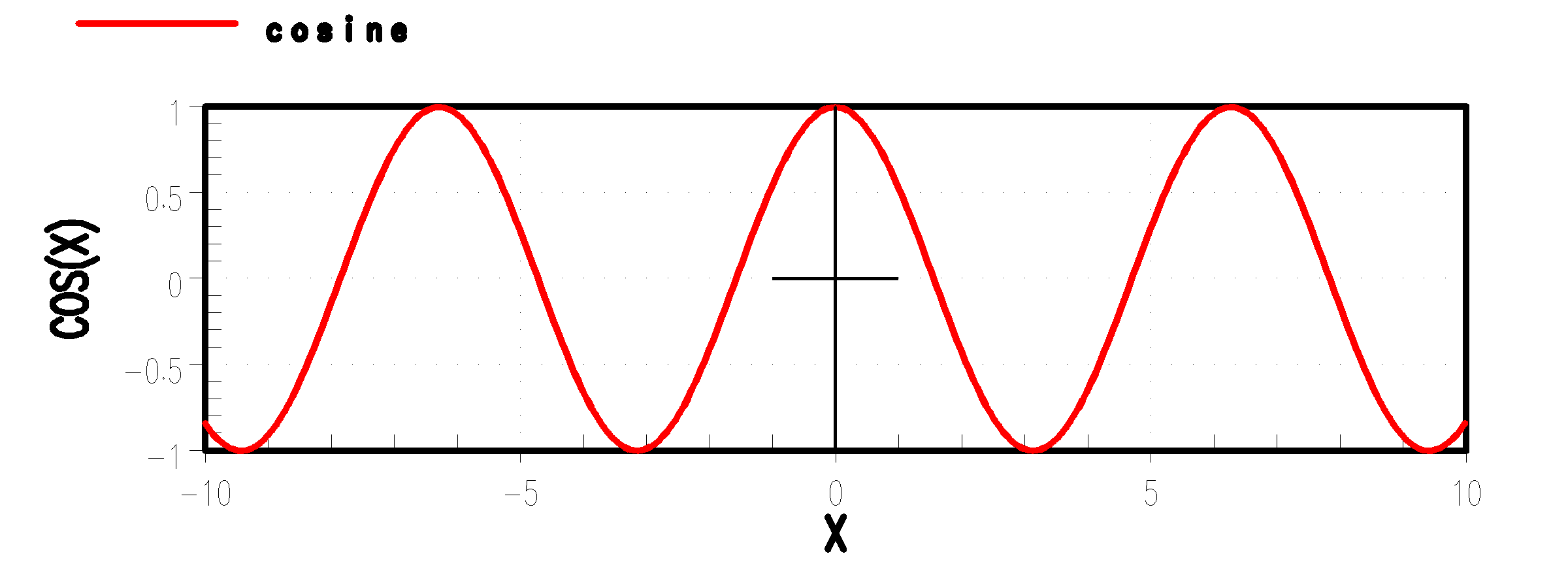Manual Reference Pages - cos (3fortran)
COS(3) - [MATHEMATICS:TRIGONOMETRIC] Cosine function
SYNOPSIS
result = cos(x)
elemental TYPE(kind=KIND) function cos(x)TYPE(kind=KIND),intent(in) :: x
CHARACTERISTICS
o X is of type real or complex of any valid kind. o The returned value will be of the same type and kind as the argument X.
DESCRIPTION
COS(3) computes the cosine of an angle X given the size of the angle in radians.
The cosine of a real value is the ratio of the adjacent side to the hypotenuse of a right-angled triangle.
OPTIONS
o X : The angle in radians when X is of type real. If X is of type complex, its real part is regarded as a value in radians, often called the phase.
RESULT
The return value is the cosine of X.
If X is type real, the return value lies in the range -1 <= COS(X) <= 1 [char46]
EXAMPLES
Sample program:
program demo_cos implicit none real,parameter :: PI=atan(1.0d0)*4.0d0 real :: val character,parameter :: nl=NEW_LINE(’A’) write(*,’(*(g0))’,advance=’no’) &Results:’basics:’, nl, & ’ COS(0.0) = ’, cos(0.0), nl, & ’ COS(PI) = ’, cos(PI), nl, & ’ ’, nl, & ’X may be any real value’, nl, & ’ COS(222*PI) = ’, cos(222*PI), nl, & ’ COS(-333*PI) = ’, cos(-333*PI), nl, & ’ ’, nl, & ’note: probably not exactly zero ....’, nl, & ’ COS(PI/2.0)= ’, cos(PI/2.0), nl, & ’ EPSILON= ’, epsilon(PI), nl, & ’ ’, nl, & ’COS() is elemental’, nl, & ’ COS([0.0,PI/4,PI/2,PI*3/4,PI]) = ’, nl write(*,’(*(1x,g0,1x))’) COS([0.0,PI/4,PI/2,PI*3/4,PI])
write(*,’(*(g0))’,advance=’no’) & ’ ’, nl, & ’Law of Cosines:’, nl, & ’ ’, nl, & ’right triangle’, nl, & two_sides_and_degrees_between(3.0,4.0,90.0), nl, & ’equilateral’, nl, & two_sides_and_degrees_between(3.3,3.3,60.0), nl, & ’ ’, nl, & ’Dusty Corners:’, nl, & ’ ’, nl, & ’If very large, representable numbers are far apart’, nl, & ’so adding or subtracting a few radians can not even’, nl, & ’change the value! Note the expected values here:’, nl val=0.0 call delta( val-2.0, val-1.0 )
write(*,’(a)’) ’but look at the same call when the values are huge;’ val=huge(0.0)/1000 call delta( val-2.0, val-1.0 )
contains
subroutine delta(A,B) real(kind=kind(0.0)),intent(in) :: a,b print ’(a,t30,g0)’ , & ’ A= ’, A, & ’ B= ’, B, & ’ B-A= ’, B-A, & ’ COS(A*PI)= ’, cos(A*PI), & ’ COS(B*PI)= ’, cos(B*PI), & ’ spacing(A)= ’, spacing(A), & ’ COS((B-A)*PI)= ’, cos((B-A)*PI), & ’ COS(B*PI)-COS(A*PI)= ’, cos(B*PI)-cos(A*PI), & repeat(’=’,40) end subroutine delta
function two_sides_and_degrees_between(a,b,X) result(str) real,intent(in) :: a,b,X real :: c real,parameter :: PI = atan(1.0d0) * 4.0d0 real,parameter :: degrees_to_radians = PI / 180.0 character,parameter :: nl=NEW_LINE(’A’) character(len=:),allocatable :: str ! The law of cosines states that for a ! triangle with sides of length a, b, and c ! that if the angle X is formed by sides a and ! b that the length of the third side c is ! c = sqrt( a**2 + b**2 - 2*a*b*cos(degrees_to_radians*X) ) allocate( character(len=132) :: str ) write(str,’(*(g0))’)& ’For sides A=’,a,’, B=’,b,’ and X=’,x,’ degrees,’,nl,’side C=’,c str=trim(str) ! ! \ ! / \ ! / Y \ ! / \ ! / \ ! / \ ! b / \ c ! / \ ! / \ ! / \ ! / \ ! / X Z \ ! ------------------------- ! a end function two_sides_and_degrees_between end program demo_cos
> basics: > COS(0.0) = 1.00000000 > COS(PI) = -1.00000000 > > X may be any real value > COS(222*PI) = 1.00000000 > COS(-333*PI) = -1.00000000 > > note: probably not exactly zero .... > COS(PI/2.0)= -0.437113883E-7 > EPSILON= 0.119209290E-6 > > COS() is elemental > COS([0.0,PI/4,PI/2,PI*3/4,PI]) = > 1.00000000 0.707106769 -0.437113883E-7 -0.707106769 -1.00000000 > > Law of Cosines: > > right triangle > For sides A=3.00000000, B=4.00000000 and X=90.0000000 degrees, > side C=5.00000000 > equilateral > For sides A=3.29999995, B=3.29999995 and X=60.0000000 degrees, > side C=3.29999995 > > Dusty Corners: > > If very large, representable numbers are far apart > so adding or subtracting a few radians can not even > change the value! Note the expected values here: > A= -2.00000000 > B= -1.00000000 > B-A= 1.00000000 > COS(A*PI)= 1.00000000 > COS(B*PI)= -1.00000000 > spacing(A)= 0.238418579E-6 > COS((B-A)*PI)= -1.00000000 > COS(B*PI)-COS(A*PI)= -2.00000000 > ======================================== > but look at the same call when the values are huge; > A= 0.340282343E+36 > B= 0.340282343E+36 > B-A= 0.00000000 > COS(A*PI)= 0.766595423 > COS(B*PI)= 0.766595423 > spacing(A)= 0.396140813E+29 > COS((B-A)*PI)= 1.00000000 > COS(B*PI)-COS(A*PI)= 0.00000000 > ========================================
STANDARD
FORTRAN 77
SEE ALSO
ACOS(3), SIN(3), TAN(3)
RESOURCES
Fortran intrinsic descriptions
o Wikipedia:sine and cosine
